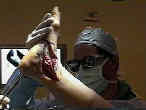- Discussion:
- may lessen the distraction of the medial arch at the superomedial portion of spring ligament (lessens ligament tension);
- may make the achilles tendon a better invertor and less of an evertor of the subtalar joint during walking;
- compensates for talo-calcaneal valgus, and may be used for both congenital and acquired pes planus;
- does not address talo-navicular subluxation / midfoot sag;
- typically, the osteotomy fragments are slide 1 cm;
- as noted by Michelson et al, medial sliding osteotomy change the stress distrubtion pattern in the ankle, and may
predispose the patient to premature ankle arthritis;
- some have theorized that this procedure produces correction of the flat foot deformity by tightening the plantar fascia;
- as noted by Horton et al, plantar fascia tightening did not occur w/ medial calcaneal osteotomy;
- these results were confirmed by Thordarson et al 1998 in a similar study;
- in the report by Nyska et al, the authors performed an antomic study which attempted to define the contribution
of the Achilles tendon to the flatfoot deformity and to define the effect of a calcaneal medial displacement osteotomy;
- methods included:
- intact foot without Achilles loading;
- intact foot with Achilles loading;
- flatfoot without medial calcaneal displacement osteotomy and without Achilles loading;
- flatfoot without medial calcaneal displacement osteotomy but with Achilles loading;
- flatfoot with medial calcaneal displacement osteotomy but without Achilles loading;
- flatfoot with medial calcaneal displacement osteotomy and with Achilles loading;
- experimental flaffoot was developed by releasing the posterior tibial tendon, spring ligament, and plantar
fascia and applying 7,000 cycles of axial fatigue load (range, 700 to 1,400 N; 1-Hz frequency);
- to simulate the phase of midstance, the peroneus longus, peroneus brevis, flexor digitorum longus, and flexor hallucis longus
tendons were grasped by clamps, connected to pneumatic actuators, and loaded with precalculated forces;
- AP and lateral radiographs were obtained for each stage on which the following measurements were made: talonavicular coverage
angle, talar-first metatarsal angle, talocalcaneal angle, and height of the medial cuneiform;
- between stages 3 and 4, for all measurements, Achilles tendon loading aggravated the flatfoot deformity (p < 0.05);
- after medial calcaneal osteotomy (stages 5 and 6), the Achilles tendon contributed less to the arch-flattening;
- they found that the medial displacement osteotomy plays an important role in reducing and/or delaying the progress of flatfoot deformity;
- they concluded that in the flatfoot, loading of the Achilles tendon increases the deformity;
- medial calcaneal osteotomy significantly decreases the arch-flattening effect of this tendon and therefore limits
the potential increase of the deformity;
- Cautions:
- take care with completion of the osteotomy through the medial calcaneal cortex and that this be performed in a
carefully controlled manner to reduce the risk of post-operative complications including pain, numbness,
and hematoma formation;
- Anatomic study of the medial neurovascular structures in relation to calcaneal osteotomy.
Medial arch strain after medial displacement calcaneal osteotomy: an in vitro study.
Effect of medial displacement calcaneal osteotomy on ankle kinetics in a cadaver model.
Effect of calcaneal osteotomy and plantar fasciotomy on arch configuration in a flatfoot model.
The contribution of the medial calcaneal osteotomy to the correction of flatfoot deformities.






